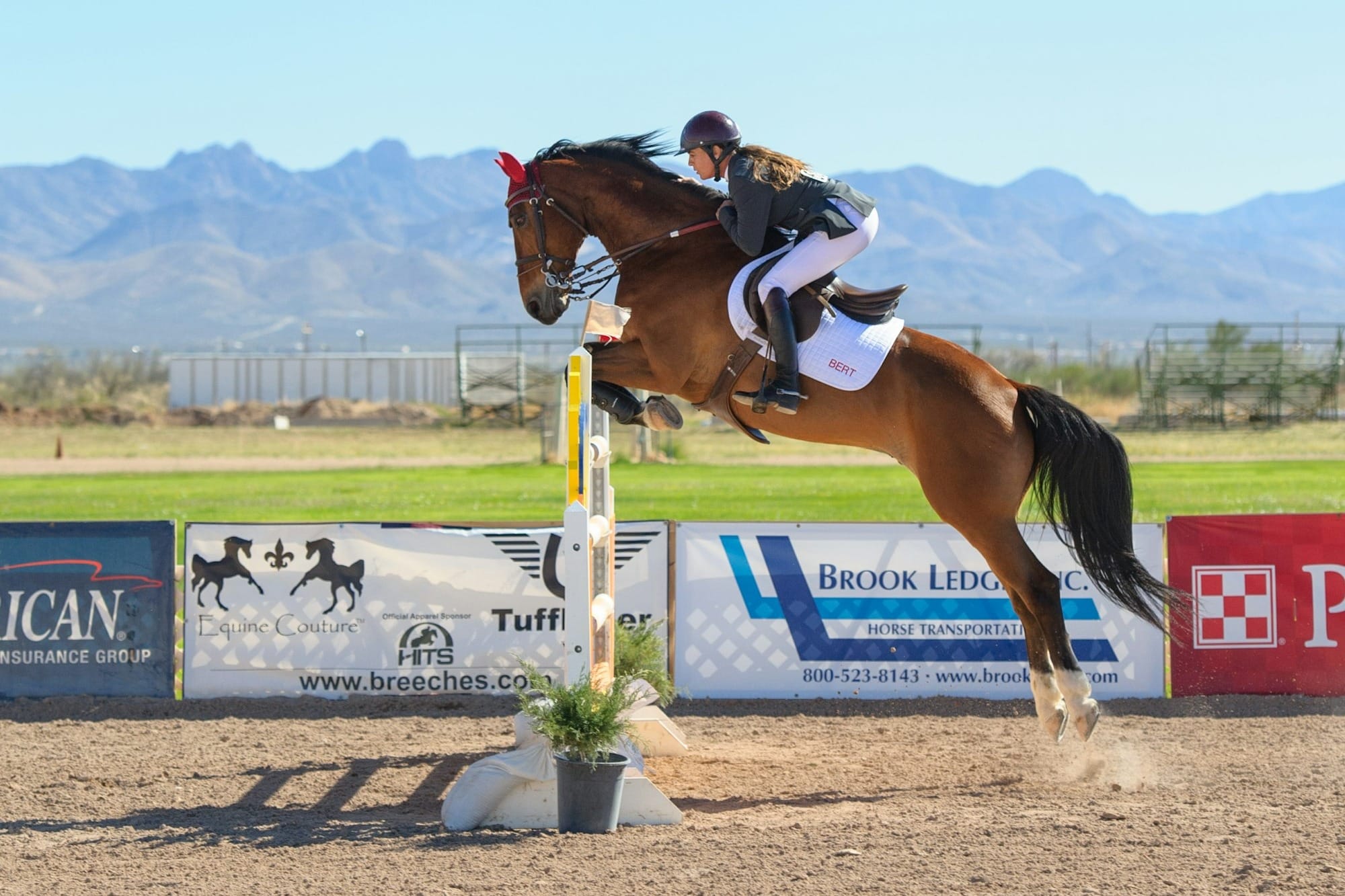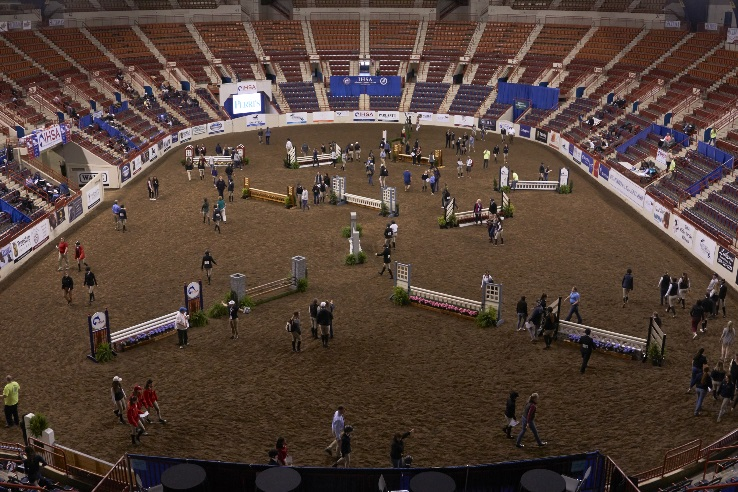Finding Your Stride: A Rider’s Guide to Jumping Distances & Footage
Curious about jumping distances? Whether you're new to course walks or just want a refresher, this guide breaks down strides, footage, and everything in between. Learn how to measure, adjust, and ride each line with confidence, because knowing the numbers makes all the difference!

If you’ve ever walked a show jumping course and heard riders talk about “that’s a four-stride line” or “the five rides a little long,” you might have wondered how those numbers are figured out. Don’t worry, you’re not alone! Understanding distances between jumps is one of the biggest milestones for riders when they progress to jumping. Once you get the hang of it, course walks will feel less like a mystery and more like a strategy session.
When riders talk about distances, they’re really talking about how many strides a horse should take between two fences. A standard horse stride is considered to be about 12 feet, and course designers use this measurement to set lines. For example, a four-stride line is typically set at about 60 feet (12 feet per stride, plus a few feet for landing and takeoff). Walking the course helps riders confirm these measurements in real time, while also adjusting for factors like their horse’s natural stride length, whether the line rides uphill or downhill, and how tight the turn is coming into it.
Learning to measure and ride distances matters because it connects the numbers on the ground with the feel in the saddle. Knowing the math gives you a framework, but adjusting for your horse’s rhythm, pace, and balance is what brings the ride together. The better you get at seeing and feeling distances, the smoother and more confident your rounds will become.
Let’s break down what those numbers mean, how distances are measured, and why it all matters for your ride.

The Basics: One Horse Stride
Course designers generally work off the idea that one horse stride equals about 12 feet. To make things rideable, they also add:
- 6 feet for takeoff
- 6 feet for landing
So, when you’re walking a course, you’re not just counting strides, you’re also factoring in that “extra” room on either side of the fence.
Common Distances Between Jumps
Here are some standard guidelines for how far apart jumps might be set, based on stride count:
- One stride – about 24 feet (12 feet for the stride + 6 feet landing + 6 feet takeoff)
- Two strides – about 36 feet
- Three strides – about 48 feet
- Four strides – about 60 feet
- Five strides – about 72 feet
If you ride ponies or have a horse with a shorter stride, these numbers may ride a little long. On the other hand, if you’re on a big-strided warmblood, some lines may feel short. That’s why learning to adjust is just as important as memorizing numbers.
Related Distances vs. Combinations
- Related DistancesThese are lines with three or more strides between jumps (think 48–72 feet). They test your ability to keep rhythm and decide whether to ride the “normal” stride count or adjust slightly forward or back depending on your horse’s step.
- Combinations These are tighter, with just one or two strides between fences (24–36 feet). Combinations require quick reactions and precise riding—you don’t have much room to make corrections once you’re in.
In short, related distances test your ability to manage rhythm and stride length over a longer line, while combinations demand accuracy and split-second decisions in a much tighter space. Both challenge rider feel and horse adjustability in different ways, and mastering each is key to confident, polished rounds.
How to Walk Distances Like a Pro
When walking the course, here’s a handy way to check distances:
- Step off six feet from the first fence to account for the landing.
- Walk forward, counting four of your own steps as one horse stride (most people’s steps are about three feet each).
- Stop six feet before the next jump for the takeoff.
This tells you how many strides your horse is meant to fit in—and gives you time to decide whether you’ll need to steady, add, or ride forward to make it work.
OR
- Count 4 of your own steps first, 2 steps (6 feet) for takeoff and 2 steps (6 feet) for landing.
- Walk forward counting 4 of your own steps (12 feet) for each stride.
Factors That Change the Ride
Even though distances are set with averages in mind, no two horses (or courses) are exactly the same. Things that can affect how a line rides include:
- Type of jump – Oxers ride a little longer than verticals because horses land farther out.
- Bending lines - These are often set on the “half stride” and your track will determine if you do one more or one less stride.
- Arena conditions – Deep footing shortens strides, while firm, springy footing lengthens them.
- Direction of travel – Uphill lines ride shorter; downhill lines ride longer. Going toward the ingate rides a little shorter; going away from the ingate may ride a little longer.
- Your horse’s stride – Compact, pony-like stride vs. big, ground-covering stride.
Knowing this helps you make smart choices during your round instead of just “trusting the numbers.”
Why It Matters
Being comfortable with distances is one of the foundations of a confident ride. When you know how to see a line and ride it well, your rhythm stays smoother, your horse trusts your guidance, and those awkward “oh no” takeoff spots become far less frequent.
With practice, you’ll also develop an eye for when to adjust forward or back, giving you more control and finesse in the saddle. The result? Rounds that not only feel better but also look more polished and professional to trainers, judges, and spectators alike.
Final Thoughts
Think of distances as the roadmap of your course. The numbers give you the framework, but your feel in the saddle brings it to life. The more you practice walking lines, counting strides, and riding with adjustability, the more confident you’ll become, and your horse will thank you for it.
Good riders don’t just memorize numbers; they learn to adapt. A long approach might call for patience, while a bending line asks for balance and precision. Sometimes the best ride isn’t the textbook number of strides, but the one that keeps rhythm flowing and your horse jumping out of stride. That’s where your eye, your seat, and your timing come together to turn math into magic.
So next time you walk into the arena, remember: it’s not just about jumping the fences — it’s about finding the perfect dance between stride, space, and style. With practice, those numbers become second nature, and every course starts to feel less like a puzzle and more like a performance.
Need more help figuring out distances? Join the conversation on TurnoutHQ, where riders swap tips, share strategies, and learn from each other’s experiences.
Sources
https://practicalhorsemanmag.com/training/introduction-to-related-distances-and-combinations

